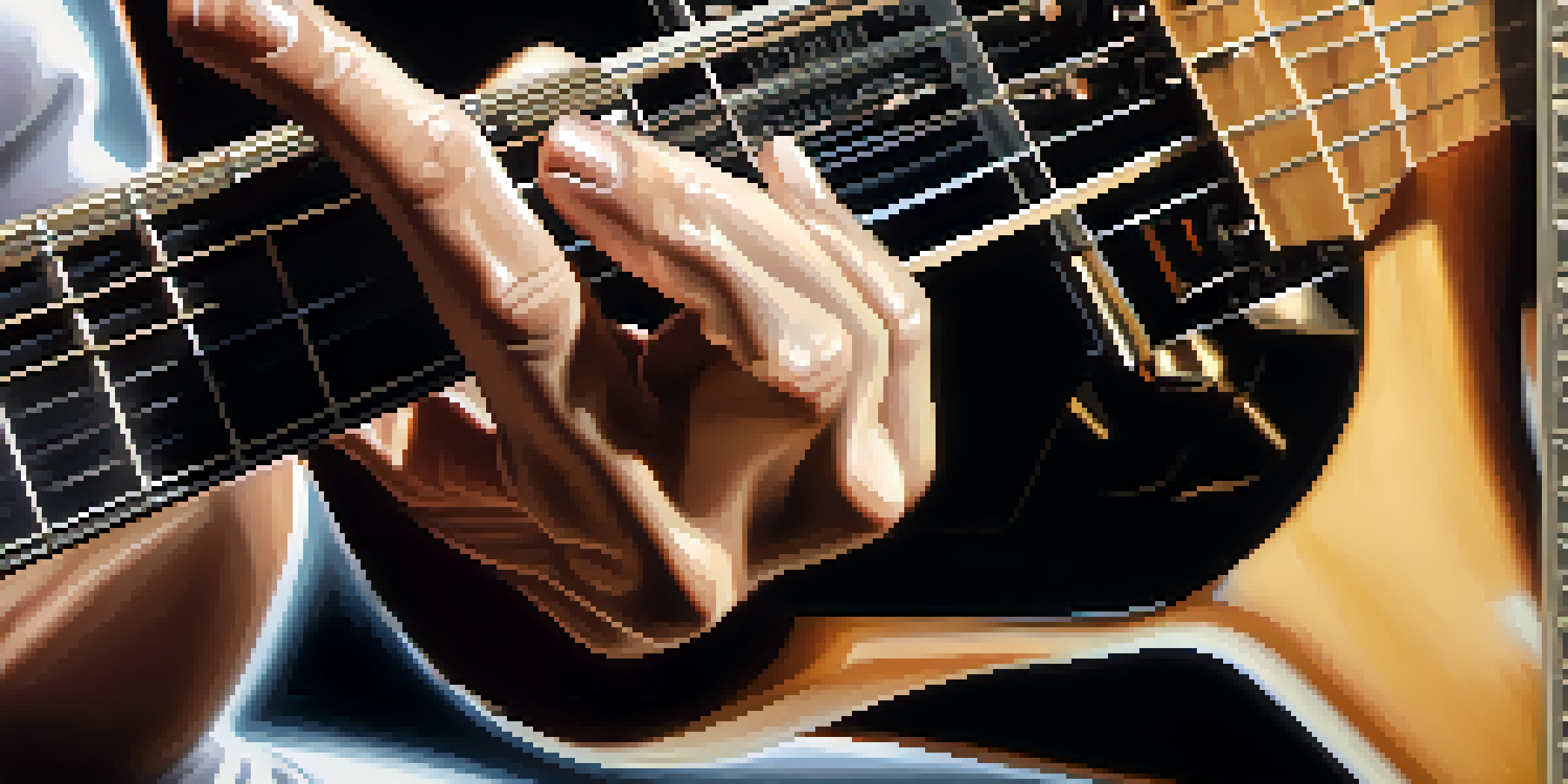Advanced Guitar Warm-Up Techniques for Proficient Players

Understanding the Importance of Warm-Ups for Guitarists
Warm-ups are crucial for professional guitarists, serving as a bridge between practice and performance. They prepare your fingers and mind for the technical challenges ahead, helping to prevent injuries and fatigue. Just like athletes stretch before a game, musicians need to warm up to achieve peak performance.
Practice does not make perfect. Only perfect practice makes perfect.
A well-structured warm-up routine can significantly enhance your dexterity, speed, and overall technique. By focusing on specific muscle groups and movements, you can fine-tune your playing and address any weaknesses. This not only boosts your confidence but also improves your ability to express musical ideas fluidly.
Moreover, incorporating warm-up techniques into your daily routine can lead to long-term benefits. It cultivates discipline and sets a positive tone for practice sessions, ensuring that you're mentally and physically aligned. Ultimately, a good warm-up can make a noticeable difference in your overall guitar playing.
Finger Exercises to Boost Dexterity and Speed
One effective way to enhance your dexterity and speed is through targeted finger exercises. Simple patterns, like the spider exercise, where you play each finger in sequence across the fretboard, can dramatically improve your finger independence. This exercise encourages fluid movement and builds strength in your fingers.

You can also try scales and arpeggios at varying tempos to challenge your speed. Start slow, ensuring accuracy, and gradually increase the tempo as you become more comfortable. This method not only warms up your fingers but also reinforces your understanding of scales and harmonic structures.
Warm-Ups Enhance Performance
Effective warm-up routines prepare guitarists physically and mentally, improving technique and preventing injuries.
Incorporating these exercises into your warm-up routine can lead to significant improvements. As you practice, you’ll find that your fingers become more agile, allowing you to tackle more complex pieces effortlessly. Consistent practice with these techniques can elevate your guitar performance to new heights.
Developing Hand Coordination with Chromatic Exercises
Chromatic exercises are fantastic for developing hand coordination and finger strength. By playing sequences of four notes on adjacent frets, you can train your hands to work together seamlessly. This type of exercise emphasizes not only finger movement but also the synchronization between your left and right hands.
Guitar playing is not about how many notes you play, but how much you feel those notes.
As you progress, vary the patterns and rhythms to keep things interesting. For example, you could alternate between ascending and descending sequences or incorporate rests. This variation not only keeps your practice engaging but also challenges your coordination in different ways.
The more you practice chromatic exercises, the more natural your finger movements will become. This can lead to greater precision in your playing, making it easier to navigate complex solos or intricate chord changes. In time, you'll notice an enhanced ability to express yourself musically.
Incorporating Stretching to Prevent Injuries
Stretching is often overlooked in guitar warm-ups, yet it's vital for preventing injuries. Just as athletes stretch to prepare their muscles, guitarists should do the same for their fingers, hands, and arms. Simple stretches can enhance blood flow and flexibility, reducing the risk of strains during intense practice sessions.
Try incorporating wrist rotations, finger pulls, and arm stretches into your warm-up routine. These movements not only help alleviate tension but also promote a sense of relaxation before you dive into playing. Remember that a relaxed body is crucial for optimal performance.
Finger Exercises Boost Skills
Targeted finger exercises improve dexterity and speed, enabling players to tackle complex pieces with ease.
Adding stretching to your warm-up can lead to a more enjoyable playing experience. With increased flexibility and reduced tension, you can focus more on your music rather than discomfort. Over time, this practice will help maintain your physical health as a guitarist.
Using Backing Tracks for Rhythm and Timing Practice
Backing tracks are an excellent tool for warming up while also honing your rhythm and timing. By playing along with a metronome or backing track, you can practice staying in time while working on your scales or improvisation. This not only keeps your warm-up engaging but also simulates real performance scenarios.
Choose backing tracks that challenge you at various tempos and styles. This variety will help you adapt your playing to different musical contexts and improve your overall timing. Plus, jamming along with tracks can be a fun way to make warm-ups feel less like a chore.
As you incorporate backing tracks into your warm-up, you'll notice improvements in your groove and musicality. This practice can bridge the gap between technical exercises and actual performance, making you a more versatile player. Embracing this approach can lead to exciting new discoveries in your playing.
Exploring Advanced Techniques: Legato and Staccato
Incorporating advanced techniques like legato and staccato into your warm-ups can greatly enhance your expressiveness. Legato, characterized by smooth, connected notes, requires precise finger control and coordination. Practicing legato exercises can help you achieve a fluid, melodic sound that captivates your audience.
On the other hand, staccato emphasizes detached, crisp notes. This technique adds a dynamic edge to your playing, making it essential for various styles. By practicing both techniques, you can cultivate a more diverse sound palette, allowing you to tackle a wider range of musical expressions.
Personalized Routines Drive Growth
Creating a tailored warm-up routine focuses practice on individual goals, ensuring more effective skill development.
Integrating these techniques into your warm-up routine not only boosts your technical abilities but also enhances your creativity. As you become comfortable with legato and staccato, you'll find it easier to experiment with different musical ideas. This exploration can lead to exciting breakthroughs in your guitar playing.
Creating a Personalized Warm-Up Routine
Crafting a personalized warm-up routine is key to maximizing your practice sessions. Consider your goals and the specific areas you want to improve, whether it's speed, coordination, or musicality. Tailoring your warm-up to address your needs will ensure that you get the most out of your time spent playing.
Start by selecting a few exercises that resonate with you and mix them into a cohesive routine. For instance, you might begin with finger exercises, followed by chromatic runs, and conclude with stretching. Having a structured approach will keep you organized and focused during your warm-ups.

Remember, consistency is essential for improvement. As you refine your routine, take note of your progress and make adjustments as necessary. A well-thought-out warm-up can become an invaluable part of your practice, setting the stage for a successful playing experience.